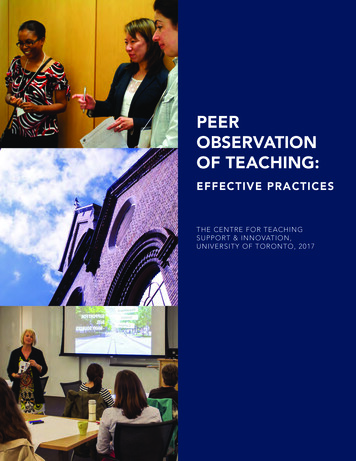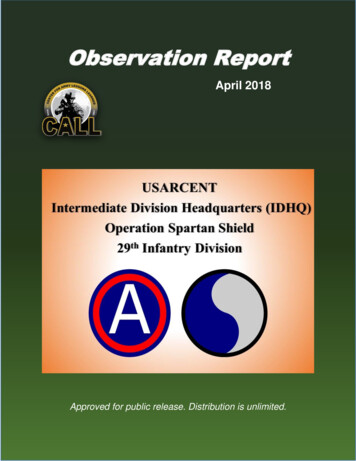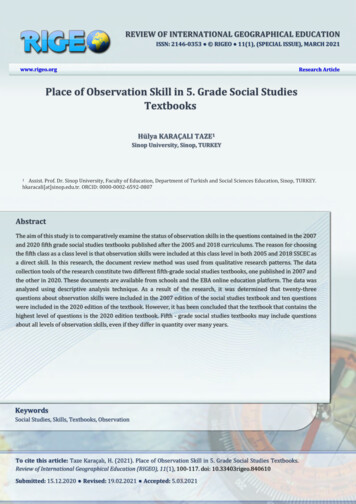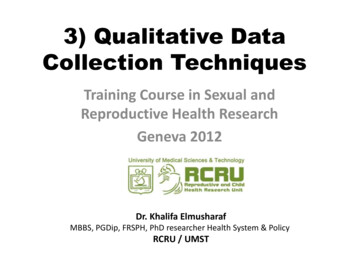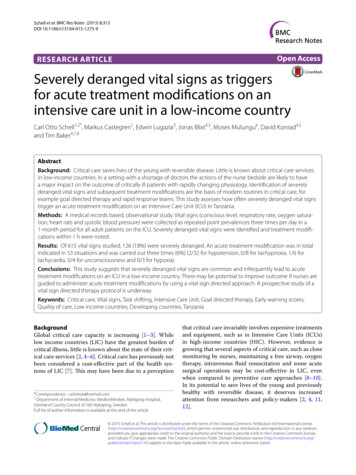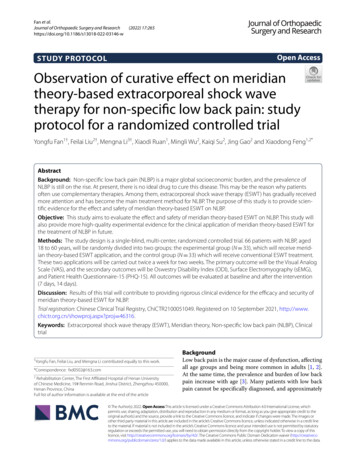
Transcription
Fan et al.Journal of Orthopaedic Surgery and (2022) 17:265Open AccessSTUDY PROTOCOLObservation of curative effect on meridiantheory‑based extracorporeal shock wavetherapy for non‑specific low back pain: studyprotocol for a randomized controlled trialYongfu Fan1†, Feilai Liu2†, Mengna Li3†, Xiaodi Ruan1, Mingli Wu2, Kaiqi Su2, Jing Gao2 and Xiaodong Feng1,2*AbstractBackground: Non-specific low back pain (NLBP) is a major global socioeconomic burden, and the prevalence ofNLBP is still on the rise. At present, there is no ideal drug to cure this disease. This may be the reason why patientsoften use complementary therapies. Among them, extracorporeal shock wave therapy (ESWT) has gradually receivedmore attention and has become the main treatment method for NLBP. The purpose of this study is to provide scientific evidence for the effect and safety of meridian theory-based ESWT on NLBP.Objective: This study aims to evaluate the effect and safety of meridian theory-based ESWT on NLBP. This study willalso provide more high-quality experimental evidence for the clinical application of meridian theory-based ESWT forthe treatment of NLBP in future.Methods: The study design is a single-blind, multi-center, randomized controlled trial. 66 patients with NLBP, aged18 to 60 years, will be randomly divided into two groups: the experimental group (N 33), which will receive meridian theory-based ESWT application, and the control group (N 33) which will receive conventional ESWT treatment.These two applications will be carried out twice a week for two weeks. The primary outcome will be the Visual AnalogScale (VAS), and the secondary outcomes will be Oswestry Disability Index (ODI), Surface Electromyography (sEMG),and Patient Health Questionnaire-15 (PHQ-15). All outcomes will be evaluated at baseline and after the intervention(7 days, 14 days).Discussion: Results of this trial will contribute to providing rigorous clinical evidence for the efficacy and security ofmeridian theory-based ESWT for NLBP.Trial registration: Chinese Clinical Trial Registry, ChiCTR2100051049. Registered on 10 September 2021, http:// www. chictr. org. cn/ showp roj. aspx? proj 46316.Keywords: Extracorporeal shock wave therapy (ESWT), Meridian theory, Non-specific low back pain (NLBP), Clinicaltrial†Yongfu Fan, Feilai Liu, and Mengna Li contributed equally to this work.*Correspondence: fxd0502@163.com2Rehabilitation Center, The First Affiliated Hospital of Henan Universityof Chinese Medicine, 19# Renmin Road, Jinshui District, Zhengzhou 450000,Henan Province, ChinaFull list of author information is available at the end of the articleBackgroundLow back pain is the major cause of dysfunction, affectingall age groups and being more common in adults [1, 2].At the same time, the prevalence and burden of low backpain increase with age [3]. Many patients with low backpain cannot be specifically diagnosed, and approximately The Author(s) 2022. Open Access This article is licensed under a Creative Commons Attribution 4.0 International License, whichpermits use, sharing, adaptation, distribution and reproduction in any medium or format, as long as you give appropriate credit to theoriginal author(s) and the source, provide a link to the Creative Commons licence, and indicate if changes were made. The images orother third party material in this article are included in the article’s Creative Commons licence, unless indicated otherwise in a credit lineto the material. If material is not included in the article’s Creative Commons licence and your intended use is not permitted by statutoryregulation or exceeds the permitted use, you will need to obtain permission directly from the copyright holder. To view a copy of thislicence, visit http:// creat iveco mmons. org/ licen ses/ by/4. 0/. The Creative Commons Public Domain Dedication waiver (http:// creat iveco mmons. org/ publi cdoma in/ zero/1. 0/) applies to the data made available in this article, unless otherwise stated in a credit line to the data.
Fan et al. Journal of Orthopaedic Surgery and Research(2022) 17:265Page 2 of 785% of cases cannot be attributed to specific pathological changes or nerve root irritation [4]; therefore, mostpatients with low back pain have NLBP [5]. Pain and dysfunction are common features of NLBP [6, 7].At present, most treatments for NLBP have limited efficacy and a high recurrence rate [8]. The main purpose ofclinical treatment of NLBP is to relieve pain and improvethe quality of life of patients. There are many clinicaltreatments for NLBP, including conservative therapy andsurgery [9–11]. Conservative therapy including bed rest,drug therapy, physical exercise, and exercise therapy canrelieve NLBP to a certain extent, but there are also manydrawbacks; Surgical treatment is accompanied by problems such as postoperative infection and poor long-termefficacy, and the high cost brings a heavy economic burden to patients [12]. Therefore, there is an urgent needfor a safe, effective, and economical treatment for NLBP.ESWT has been extensively used for the treatmentof NLBP in recent years [13, 14]. ESWT is a therapeutic method that applies shock waves to lesions from theinner body to boost blood flow and stimulate or reactivate affected connective tissue (including tendons andbones) to relieve pain and improve dysfunction [15].Recently, based on the meridian theory of TraditionalChinese Medicine(TCM), ESWT combined with acupoint stimulation has played a therapeutic role [16]. Thepurpose of this study is to observe the clinical efficacy ofmeridian theory-based ESWT on pain and dysfunctionin NLBP patients.The volunteers will complete the VAS, ODI, sEMG, andPHQ-15 assessments. The study flowchart is shown inFig. 1. The trial process chart is shown in Table 1.MethodsStudy designThis is a single-blind, multi-center, randomized placebocontrolled trial supported by Henan Provincial Administration of TCM. The trial will be jointly conducted bythree centers in Zhengzhou, China: the First AffiliatedHospital of Henan University of CM, Henan Provincial Hospital of CM, and the Third Affiliated Hospitalof Henan University of CM. Patients between 18 and60 years of age with NLBP will be included. When participants are eligible for inclusion after being informedabout the purpose and procedures of the study, they willbe asked to sign an informed consent form. Then, Sixtysix patients will be recruited and randomly assigned totwo groups: the experimental group (N 33) and thecontrol group (N 33). Participants in the experimentalgroup will receive ESWT based on meridian theory andparticipants of the control group will receive conventional ESWT treatment. Patients will be treated twice aweek for two weeks. All the participants will be assessed3 times: baseline (evaluation before treatment), the middle of the treatment (7 days after treatment starts), andthe end of the treatment (14 days after treatment starts).Ethics committee approvalThis trial was reviewed by the ethics committee of theFirst Affiliated Hospital of Henan University of CM onAugust 24, 2021 (reference number: 2021HL-203-01).Written informed consent will be obtained from all participants. The study was registered with the ChineseClinical Trial Registry (Identifier ChiCTR2100051049.)ParticipantsThe main participants will be recruited independentlythrough the outpatient and inpatient systems of threehospitals in China—(the First Affiliated Hospital ofHenan University of CM, Henan Provincial Hospital ofCM, and the Third Affiliated Hospital of Henan University of CM). To recruit participants, three independentcenters will publish individually online study advertisements through hospital websites and WeChat and wewill also put up posters and distribute leaflets offline incrowded areas of the hospital. The recruitment of participants began on 15 September 2021 and is expected toend on 9 December 2022, or it may be completed earlierif a sufficient number of patients are recruited.Inclusion criteriaParticipants meeting the following criteria will beincluded:1. Male or female patients aged 18–60;2. Low back pain that persists for more than threemonths without a specific cause;3. VAS score greater than 3 points;4. Patients with normal intelligence and language skills;5. NLBP patients who have not received any treatmentin the past two weeks;6. Agree to receive only ESWT-related treatments during treatment;7. Willing to volunteer for the trial and provideinformed consent.Exclusion criteriaParticipants who report any of the following will beexcluded:1. Patients will be excluded when low back pain iscaused by specific pathological factors such astumors, Osteoporosis, lumbar fractures, rheumatoidarthritis;
Fan et al. Journal of Orthopaedic Surgery and Research(2022) 17:265Page 3 of 7Fig. 1 Flowchart of the trial2. The lower extremities are affected by neurologicalmalfunction due to NLBP;3. Known or suspected serious congenital or acquiredspinal pathology, lumbar disc herniation with nervesymptoms, spinal deformity, spondyloarthropathy,etc.;4. Patients with other serious diseases such as immunediseases, endocrine diseases, and abnormal liver andkidney functions;5. Patients deemed by researchers as ineligible to participate due to severely abnormal/unstable laboratorytest results or vital signs;6. ESWT -phobic patients.Elimination criteria1. Patients who do not meet the diagnostic criteria forNLBP and are erroneously included;2. Patients who are judged by the researchers as unsuitable to continue the trial because of serious adversecomplications.
Fan et al. Journal of Orthopaedic Surgery and Research(2022) 17:265Table 1 Timing of treatment assessments and data collectionTimepointStudy periodEnrolmentBaselineTreatment phase 1 week0 week1 week2 weeksEnrolmentEligibility screenInformed consentMedical historyMerger diseaseRandomization InterventionsExperimental group AssessmentsVASODI Control group sEMGSafety evaluationAdverse events control group received conventional ESWT treatmentcan reduce the level of the VAS scale by 3.45 1.31 and2.33 1.13, respectively. The significance test level was0.05, and the test power was 0.9. The sample size was calculated by using:2N 2 zα zβ σ/δN is the required sample size for each group, and thesample size of each group is equal. Where α is 0.05 and βis 0.1, the normal distribution quantile table shows that: Page 4 of 7Zα/2 1.96, and Zβ 1.282. σ and δ represent the population standard deviationand allowable error, which are 1.31 and 1.12, respectively.By substituting the above data into the formula, 29 caseswill be needed in each group. Taking into account the10% expulsion rate, a total sample of 66 participants willbe sufficient. Interventions RandomizationParticipants who are eligible in the screening phase andagree to sign the consent form will be randomly assignedto the experimental group or the control group. The random sequence numbers will be generated through thecomputer. The allocation will be concealed using consecutively numbered sealed and opaque envelopes. Forthis, an independent researcher who will not participatein other study procedures will carry out the randomisation process to avoid bias. The allocation sequence willbe generated by a specialized statistician who does notparticipate in this experiment. Relevant independentresearchers in three centres will recruit participants andassign them to two different intervention groups.BlindingThis is a single-blind study. All other researchers, suchas assessors and data analysts, will be unaware of groupassignments. To confirm whether participants achievedblinding, assessors will use a "blinding test" questionnaireto ask participants what type of treatment they think theyreceived after the first and final treatment.Sample size calculationWe will conduct this study in a randomized controlledtrial design method and the main observed outcomewas the improvement of patients’ pain. Previously, weconducted a small sample(12 cases) of clinical observation and found that the 1-week experimental groupreceived ESWT with meridian theory-based and theThe intervention treatment period will include 4 sessionsduring 2 weeks. Licensed medical doctors who are bothering at least 4 years of clinical experience will performthe intervention, and we will conduct standardized training for the clinicians who implement the treatment inthe three research centers before the treatment and tryto maintain the consistency of the research. Meanwhile,each patient will receive the same routine therapeuticdrug and rehabilitation. The interventions for the twogroups are as follows:Routine therapeutic drug treatment: All patientswill use blood pressure control, blood lipid adjustment,blood sugar control, and nutritional nerve drug as routine therapeutic drug treatment following the physicians’instructions.Extracorporeal shock wave intervention: ESWT willbe applied by a BTL-5000 pneumatic ballistic ESWTmachine, 8.0–10 Hz, 1.6–3.0 bar energy density, 2000pulses, twice a week for two weeks.The experimental group: In addition to the routinetreatment for patients with low back pain, ESWT will alsobe performed at Huantiao(GB30), L25), Sanjiaoshu(BL22), Chengfu(BL36),Yaoyan(EX-B7) and Yaoyi (EX-B6) in the experimentalgroup [17] (Table 2).The control group: The patient will be placed in theprone position to expose below the seventh rib and abovethe gluteal groove. The clinician will use the thumbs ofboth hands to press and palpate from the middle to thesides with the strength that the patient can bear, and
Fan et al. Journal of Orthopaedic Surgery and Research(2022) 17:265Page 5 of 7Table 2 Locations of acupoints for ESWTAcupointsLocationHuantiao (GB30)In the buttocks region, at the junction of the lateral one-third and medial two-thirds of the line connecting the prominence ofthe greater trochanter with the sacral hiatusBaihuanshu (BL30)In the sacral region, at the same level as the fourth posterior sacral foramen, 1.5 B-cun lateral to the median sacral crestXiaochangshu (BL27)In the sacral region, at the same level as the first posterior sacral foramen, and 1.5 B-cun lateral to the median sacral crestPangguangshu (BL28)In the sacral region, at the same level as the second posterior sacral foramen, and 1.5 B-cun lateral to the median sacral crestGuanyuanshu (BL26)In the lumbar region, at the same level as the inferior border of the spinous process of the fifth lumbar vertebra (L5), 1.5 B-cunlateral to the posterior median lineQihaishu (BL24)In the lumbar region, at the same level as the inferior border of the spinous process of the third lumbar vertebra (L3), 1.5 B-cunlateral to the posterior median lineDachangshu (BL25)In the lumbar region, at the same level as the inferior border of the spinous process of the fourth lumbar vertebra (L4), 1.5B-cun lateral to the posterior median lineSanjiaoshu (BL22)In the lumbar region, at the same level as the inferior border of the spinous process of the first lumbar vertebra (L1), 1.5 B-cunlateral to the posterior median lineChengfu (BL36)In the buttock region, at the midpoint of the gluteal foldYaoyan (EX-B7)In the lumbar region, au niveau du rebord inferieur du processus epineux L4, lateral a la ligne mediane posterieurede 3, 5 cunYaoyi (EX-B6)In the lumbar region, au niveau du rebord inferieur du processus epineux L4, lateral a la ligne mediane posterieurede 3 cunthen the doctor will mark the pressure pain points witha marker according to the shape of the muscle. ESWTwill then be performed at the tender point of the controlgroup.Outcome measuresPrimary outcomeVisual Analog Scale (VAS): Pain intensity will beassessed using VAS [18]. This questionnaire has goodreliability and validity,and has the advantages of simplicity, time-saving, convenient operation, and wideapplication to a wide range of people. On the paperwas drawn a horizontal line 10 cm long. One end ofthe horizontal line indicated no pain, the other endindicated severe pain; the middle part indicated different degrees of pain. On the horizontal line, we let thepatient mark the degree of pain based on the feelingof self. Many clinical trials for NLBP use VAS as theirmain outcome.Secondary outcomeOswestry Disability Index (ODI): The ODI will be asimple and comprehensive patient-rated outcome used toassess Lumbar spine dysfunction [19]. The ODI is usedto measure NLBP-related dysfunction and it includes 10questions about daily activities, including pain intensity,personal care, lifting, walking, sitting, standing, sleeping, sexual life, social life and traveling. The ODI has sixresponse categories. Each item scores from 0 (better) to5 (worst). Each score will be transferred into a 0 to 100scale, with lower scores indicating lesser Lumbar spinedysfunction.Surface electromyography (sEMG): The sEMG [20]evaluation is an objective method to obtain the electromyographic signal during muscle activity, which isachieved by placing surface electrodes on the musclelayer. It can perform a quantitative and qualitative analysis of the function of muscles and can study multiplemuscles in the body at the same time. It has the advantages of innovativeness, safety and reliability, convenientoperation, and objective quantification.Patient Health Questionnaire-15 (PHQ-15): Anassessment of somatization and thus the severity of itssymptoms in clinical practice and research can be doneusing the PHQ-15, a brief, self-administered questionnaire [21]. Among 15 somatic symptoms in the PHQ-15, each symptom is scored from 0 to 2 ("not bothered atall" to "bothered a lot"). Results included functional statusas assessed by the 20-item Short-Form General HealthSurvey (SF-20), self-reported sick days, and clinic visits,as well as symptom-related difficulty. All six subscales ofSF-20 decremented stepwise as PHQ-15 somatic symptoms severity increased.Data managementCase report forms(CRFs) will record all informationabout participants truthfully, completely, accurately andpromptly.All relevant information of participants will bekept strictly confidential. After the trial, the quality control team will strictly review the submitted CRFs andensure their accuracy and completeness of the CRFs.Statistical analysisWe will intend to apply SPSS V.20 software to the statistical analysis of all results. The CI will be established at 95%,
Fan et al. Journal of Orthopaedic Surgery and Research(2022) 17:265Page 6 of 7and the significance level at 0.05. Missing data refers tothe use of actual observations without imputation whenthe dropout rate does not exceed 10%. The normality testwill be applied to all data first. Then, mean SD will beused to describe the data that fit the normal distribution;medians and interquartile ranges will be used to representcentral and discrete trends in quantitative data that donot fit the normal distribution. The t-test and analysis ofvariance(ANOVA) will be applied to quantitative data, andthe rank-sum test will be applied to count data to comparedifferences between groups. Sensitivity analysis will be carried out if necessary. P 0.05 will be considered statisticallysignificant.DiscussionThe purpose of this study is to evaluate the efficacy ofmeridian theory-based ESWT in relieving pain andother symptoms which hurt the quality of life in theseindividuals with NLBP. To do this, the study involves theexperimental group and the control group, and interventions will be conducted two times per week for 2 weeks.According to some previous studies [22], meridian theory-based ESWT can produce a faster and better analgesic effect than conventional ESWT. However, no studieshave reported a difference in the effect of these two treatments in patients with NLBP. This trial comparing thetwo will fill gaps in the literature, thereby assisting physiotherapists and clinicians in clinical decision-making.The VAS is one of the most commonly used measuretables for the assessment of pain and has been validatedto detect changes in pain intensity [23]. The ODI scale isthe most widely used dysfunction assessment questionnaire and has the advantages of simplicity, time savings,convenient operation, and relevance to a wide range ofpeople [24]. The electromyographic signal measured byan sEMG is well suited for evaluating the effects of ESWTfor NLBP [25]. Therefore, they have also been used inmany studies applying ESWT for NLBP. Moreover, asboth a screening tool and a measure of somatic symptomseverity. PHQ-15 may be useful in clinical practice andresearch for checking for somatization and evaluatingsymptoms severity. These will support the main resultsand be meaningful for the overall efficacy assessment.Strengths of the study include its strictly standardizedendpoints, objective criteria, and strict quality control.The trial also has some limitations. First, this is a multicenter study conducted at three tertiary A hospitalsin China and the results may not apply to primary hospitals or other countries. Second, the therapist will notbe blinded due to the nature of the study, which mightbring bias and influence the results. To achieve our clinical goals, we will strive to standardize every step of thisstudy. We expect that the results of this trial will provideevidence of the efficacy and safety of meridian theorybased ESWT for NLBP. This will provide a practical andeffective treatment method for the clinic, which has veryimportant social significance.Withdrawal and dropoutThe patients will be excluded from the trial if they withdraw their consent or lost follow-up, or if the patient isjudged unable to continue participating. The researcherswill document in detail why the trial was interrupted andwhether each participant completed the trial.Quality controlBefore the trial, all medical workers will accept stricttraining on related tasks. The therapist in this trial haslicenses with at least 4 years of clinical experience. Monitors will inspect case report forms twice every weekand patient situations during the treatment period.Dropouts and withdrawals involving the reasons willbe documented detailedly during the trial. Participants’information will be kept strictly secret at the study siteswith limited access; Only investigators can view the data.All investigators will always maintain a strict privacy policy to protect confidentiality in the whole process of thetrial.Safety evaluation and adverse eventsThe whole trial will monitor and report all adverseevents (AEs). Any uncomfortable symptoms or diseaseduring this study will be recognized as adverse events,such as localized hematoma, allergies, pain, dizziness,vomiting, or palpitations. The study will detail recordAEs—including symptoms, onset, and end date, severity, relationship with ESWT, and outcome. Participantswill stop treating if the treatments cause serious aggravation of symptoms and undergo related tests and treatments. Researchers will immediately report SAEs (e.g.,requiring hospitalization, causing disability, or impairedability to work) to the ethics committee of the FirstAffiliated Hospital of Henan University of CM and suspend the study.AbbreviationsESWT: Extracorporeal shock wave therapy; NLBP: Non-specific low backpain; VAS: Visual analog scale; ODI: Oswestry disability index; TCM: TraditionalChinese Medicine; sEMG: Surface electromyography; PHQ-15: Patient healthquestionnaire-15; CRFs: Case report forms; AEs: Adverse events.AcknowledgmentsSpecial thanks to the First Affiliated Hospital of Henan University of CM, HenanProvincial Hospital of CM, the Third Affiliated Hospital of Henan University ofCM, and the Henan Provincial Administration of TCM for their support of thisstudy.
Fan et al. Journal of Orthopaedic Surgery and Research(2022) 17:265Page 7 of 7Author contributionsXF, FL contributed to conceptualization. YF, FL, ML, XF contributed to methodology. XF, FL contributed to resources. YF, FL contributed to data curation. YF,FL, ML contributed to software. XR, MW, KS contributed to recruit participants.YF, FL, ML contributed to writing—original draft preparation. YF, FL, MLcontributed to writing—review and editing. XF contributed to supervision. FL,JG contributed to project administration. Yongfu Fan, Feilai Liu and MengnaLi contributed equally to this work. All authors read and approved the finalmanuscript.10. Gilligan CJ, Cohen SP, Fischetti VA, et al. Chronic low back pain, bacterialinfection and treatment with antibiotics. Spine J. 2021;21(6):903–14.11. Longtin C, Décary S, Cook CE, et al. What does it take to facilitate the integration of clinical practice guidelines for the management of low backpain into practice? Part 1: a synthesis of recommendation. Pain Pract.2021;21(8):943–54.12. Xantus G, Zavori L, Matheson C, et al. Cannabidiol in low back pain: scientific rationale for clinical trials in low back pain. Expert Rev Clin Pharmacol.2021;14(6):671–5.13. Yue L, Sun M-S, Chen H, et al. Extracorporeal shockwave therapy fortreating chronic low back pain: a systematic review and meta-analysis ofrandomized controlled trials. Biomed Res Int. 2021;2021:5937250.14. Lange T, Deventer N, Gosheger G, et al. Effectiveness of radial extracorporeal shockwave therapy in patients with acute low back pain-randomized controlled trial. J Clin Med. 2021;10(23):5569.15. Notarnicola A, Maccagnano G, Gallone MF, et al. Extracorporeal shockwave therapy versus exercise program in patients with low back pain:short-term results of a randomised controlled trial. J Biol Regul HomeostAgents. 2018;32(2):385–9.16. Zhao Y, Wang X, Zhang D. A retrospective study on the efficacy of twodifferent rehabilitation interventions on KOA: shock wave therapy vselectroacupuncture therapy. Biomed Res Int. 2021;2021:2099653.17. Lee S-H, Kim C-E, Lee I-S, et al. Network analysis of acupuncture pointsused in the treatment of low back pain. Evid Based Complement AlternMed. 2013;2013: 402180.18. Chiarotto A, Maxwell LJ, Ostelo RW, et al. Measurement properties ofvisual analogue scale, numeric rating scale, and pain severity subscaleof the brief pain inventory in patients with low back pain: a systematicreview. J Pain. 2019;20(3):245–63.19. Garg A, Pathak H, Churyukanov MV, et al. Low back pain: critical assessment of various scales. Eur Spine J. 2020;29(3):503–18.20. Ebenbichler G, Habenicht R, Ziegelbecker S, et al. Age- and sex-specificeffects in paravertebral surface electromyographic back extensor musclefatigue in chronic low back pain. Geroscience. 2020;42(1):251–69.21. Kroenke K, Spitzer RL, Williams JBW. The PHQ-15: validity of a new measure for evaluating the severity of somatic symptoms. Psychosom Med.2002;64(2):258–66.22. Walewicz K, Taradaj J, Rajfur K, et al. The effectiveness of radial extracorporeal shock wave therapy in patients with chronic low back pain: aprospective, randomized, single-blinded pilot study. Clin Interv Aging.2019;14:1859–69.23. Shafshak TS, Elnemr R. The visual analogue scale versus numerical ratingscale in measuring pain severity and predicting disability in low backpain. Clin Rheumatol. 2021;27(7):282–5.24. Barone Gibbs B, Hergenroeder AL, Perdomo SJ, et al. Reducing sedentarybehaviour to decrease chronic low back pain: the stand back randomisedtrial. Occup Environ Med. 2018;75(5):321–7.25. Wei J, Zhu H-B, Wang F, et al. Clinical utility of flexion-extension ratiomeasured by surface electromyography for patients with nonspecificchronic low-back pain. J Chin Med Assoc. 2019;82(1):35–9.FundingThis work was supported by the Henan Provincial Administration of TCM.Henan Province TCM Scientific Research Special Project (20-21ZY2176).Availability of data and materialsNot applicable; no data have yet been generated.DeclarationsEthics approval and consent to participateThis trial was reviewed by the ethics committee of the First Affiliated Hospitalof Henan University of CM on August 24, 2021 (reference number: 2021HL203-01). Written informed consent will be obtained from all participants.The study was registered with the Chinese Clinical Trial Registry (IdentifierChiCTR2100051049.)Dissemination policyAfter studying consummation, the final data will be submitted by theresearcher to the Henan Administration of TCM in the form of a researchreport. Research results will be published in authoritative journals or presented at a high-level academic conference.Competing interestsThe research funders are not responsible for study design, data collection andmanagement, and manuscript writing and publishing licenses. Yongfu Fan,Feilai Liu and Mengna Li are considered co-first authors. All authors confirmedthe final version of the manuscript. All authors report no competing interestsin this work.Author details1Henan University of Chinese Medicine, Zhengzhou 450000, China. 2 Rehabilitation Center, The First Affiliated Hospital of Henan University of ChineseMedicine, 19# Renmin Road, Jinshui District, Zhengzhou 450000, Henan Province, China. 3 Institute of Pain Medicine and Special Environmental Medicine,Nantong University, Nantong 226019, China.Received: 6 April 2022 Accepted: 24 April 2022References1. Knezevic NN, Candido KD, Vlaeyen JWS, et al. Low back pain. Lancet.2021;398(10294):78–92.2. Golob AL, Wipf JE. Low back pain. Med Clin N Am. 2014;98(3):405–28.3. Chou R. Low Back Pain. Ann Intern Med, 2021, 174(8): ITC113-ITC128.4. Urits I, Burshtein A, Sharma M, et al. Low back pain, a comprehensivereview: pathophysiology, diagnosis, and treatment. Curr Pain HeadacheRep. 2019;23(3):23.5. Traeger AC, Qaseem A, Mcauley JH. Low back pain. JAMA.2021;326(3):286.6. Borenstein DG, Balagué F. Low back pain in adolescent and geriatricpopulations. Rheum Dis Clin N Am. 2021;47(2):149–63.7. Delitto A, George SZ, Van Dillen L, et al. Low back pain. J Orthop SportsPhys Ther. 2012;42(4):A1-57.8. Giordano L, Murrell WD, Maffulli N
Low back pain is the major cause of dysfunction, aecting all age groups and being more common in adults [2]. 1, At the same time, the prevalence and burden of low back pain increase with age [3]. Many patients with low back pain cannot be specically diagnosed, and approximately Open Access

